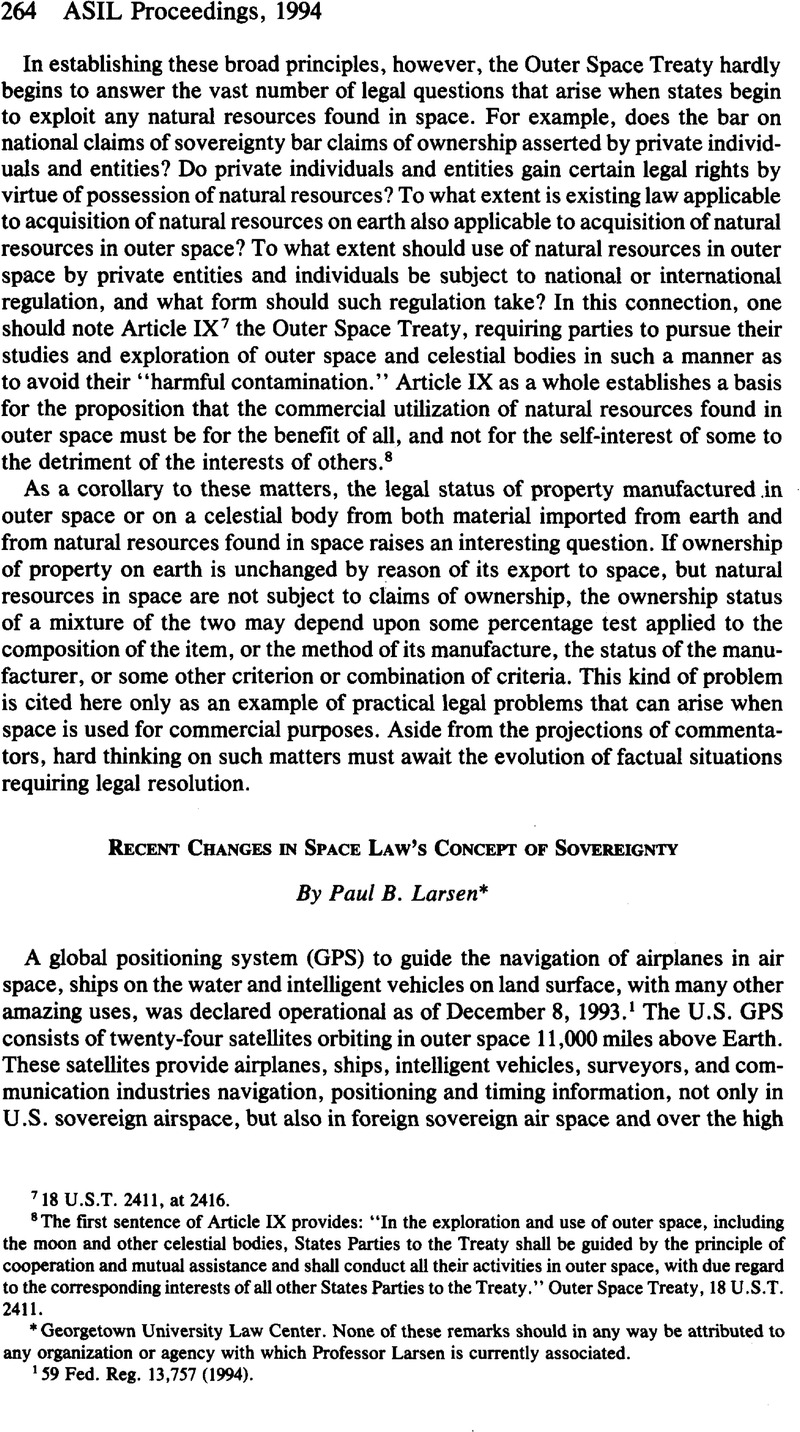No CrossRef data available.
Published online by Cambridge University Press: 28 February 2017

None of these remarks should in any way be attributed to any organization or agency with which Professor Larsen is currently associated.
1 59 Fed. Reg. 13,757(1994).
2 Id. In order to pinpoint its own location, an airplane’s on-board receiver measures distance from at least four satellites by calculating the time for the signal to arrive. See Dot/Dod Task Force, The Global Positioning System: Management And Operation Of A Dual Use System 2-9 (1993). The Federal Aviation Administration (FAA) wide area service will provide sevenmeter accuracy almost everywhere. This may have commercial implications for local differential services that may be established in other countries. One of the benefits of GPS that enhances national sovereignty is the ability to identify more precisely national boundaries, particularly boundaries over waters. Both the U.S. and Canadian Coast Guards, for example, use it to enforce fishing regulations off Nova Scotia.
3 Convention on International Civil Aviation, Dec. 7, 1944, 61 Stat. 1180 [hereinafter Chicago Convention].
4 Id at art. 2.
5 Treaty on Principles Governing the Activities of States in the Exploration and Use of Outer Space, Including the Moon and Other Celestial Bodies, Oct. 10, 1967, 128 U.S.T. 2410 [hereinafter Outer Space Treaty].
6 International Telecommunication Convention, Nov. 2, 1982, Senate Treaty Doc. 99-6, as amended. See Larsen, Paul B., Georgetown Space Law Group, DBS under FCC and International Regulation , 37 Vand. L. Rev. 67, 98-100.Google Scholar For example, ITU referred to COPUOS a claim by six equatorial nations to the geostationary orbit above their territories.
7 International Civil Aviation Organization (ICAO) Report of the Tenth Air Navigation Conference, Montreal, September 5-20, 1991, at 4-2.
8 Principles on the Use of DBS by States, GA Res. 92, GAOR Session #1 Supp. 51, at 98, UN Doc. A/37/51 [DBS Resolution]. See supra note 6 at 128-131; see also Springer, Kenneth D., Direct Broadcast Satellites: Star Wars over Cultural Integrity; paper on file at Georgetown Univ. Law Center Google Scholar.
9 Principles on the Use of DBS by States, GA Res. 92, GAOR Session #1 Supp. 51
10 Pace, Eric, TV Curb is Backed by U.N. Assembly , N.Y. TIMES, Dec. 11, 1982, at A6, col. 1Google Scholar.
11 STAR TV Changing Focus for Mass Appeal, SPACE NEWS, March 28-April 3, 1994, at 1; but see Stevenson, Richard W. and Murdoch, Mondo, Networking Globally and Relentlessly , N.Y. TIMES, May 29, 1994 Google Scholar Sec. 4. Ul, col. 1. (Stating that Mr. Murdoch terminated BBC’s news and documentaries about China as “a business decision involving his desire to develop his own news service for the region, where STAR has 3 billion potential viewers.” Chinese authorities had indicated to Mr. Murdoch their unhappiness with BBC’s program.
12 Seitz, Patrick, Current DBS Contenders Learned from Predecessors , Space News, March 21-27, 1994, at 16Google Scholar.
13 Sugawara, and Mintz, , Racing to Build a Wireless World , Wash. Post, March 24, 1994, at BlGoogle Scholar.
14 Title 15, Commerce and Trade, ch. 68, Land Remote Sensing Commercialization Act, 15 USC § 4201 (1992).
15 Principles Concerning Remote Sensing of the Earth from Space, GA Res. 41-65, Jan. 3, 1986.
16 Id.
17 Id.
18 Id.